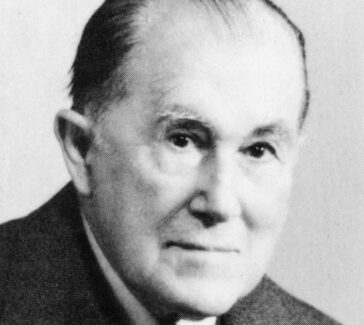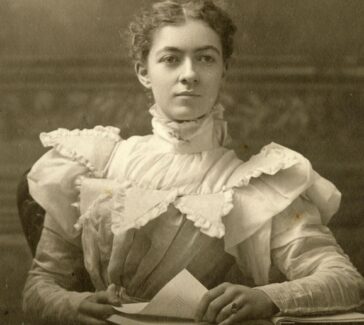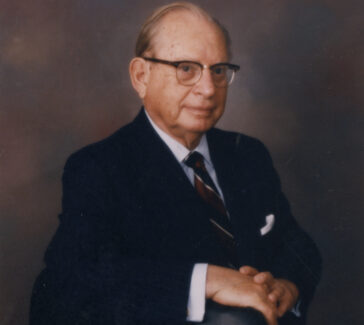George Hitchings and Gertrude Elion
Pioneers of rational drug design, Hitchings and Elion produced effective drugs for such illnesses as leukemia, gout, and malaria.
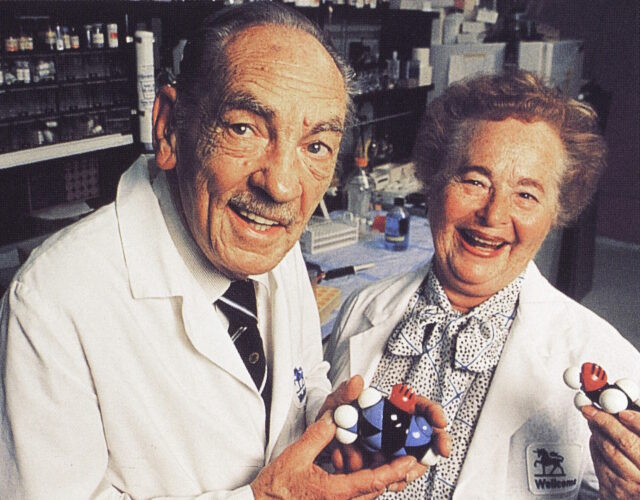
Historically, drug developments often resulted from a trial-and-error process. As a consequence, the element of chance has been essential in developing new pharmaceuticals.
George Hitchings (1905–1998) and Gertrude Elion (1918–1999) diverged from this traditional path by deliberately designing new molecules with specific molecular structures, using what today is termed rational drug design. Using this effective technique they designed compounds that would interfere with the natural production of DNA in cells and so interrupt cell growth.
Hitchings: Early Life and Education
Hitchings, the son of a shipbuilder, was born in Hoquiam, Washington. His family moved frequently along the West Coast during his early years, and his father died when he was only 12, an event that ultimately led him to pursue a career in medicine. Hitchings demonstrated an early interest in science through his selection of courses at Franklin High School in Seattle. When he graduated, his salutatorian address focused on the life and work of Louis Pasteur, whom he greatly admired for his commitment to basic research that led to practical developments.
Hitchings enrolled at the University of Washington in 1923, choosing to major in chemistry, primarily because of the enthusiasm of the chemistry faculty for their subject. He received his bachelor’s degree in 1927 and stayed on at the University of Washington to earn a master’s degree in 1928. He then attended Harvard University, where he received his PhD in biochemistry in 1933. His work at Harvard centered on analytical methods used in physiological studies of purines, which are a class of compounds, including caffeine, adenine, and guanine, composed of a two-ringed structure containing carbon and nitrogen.
Hitchings and Burroughs Wellcome
For the next decade Hitchings held a variety of temporary appointments at institutions like Western Reserve University (now Case Western Reserve) and the Harvard School of Public Health. In 1942, however, he joined the Wellcome Research Laboratories—then located in Tuckahoe, New York—as a biochemist. This research facility was operated by the British pharmaceutical firm Burroughs Wellcome and Company, which is now part of GlaxoSmithKline. Two years later Hitchings hired Gertrude Elion as a laboratory assistant, thereby beginning a lifelong collaboration on drug development.
Elion and Gender Discrimination
Elion was born in 1918 in New York City, the daughter of a successful dentist. A shy young woman, she was an excellent student, and her parents encouraged her to attend college. The death of her grandfather from stomach cancer shortly before she began her studies at Hunter College prompted her to devote her life to medicine. This dedication was renewed when, soon after her graduation in 1937 with a degree in chemistry, her fiancé died of an inflammation of the heart lining.
Elion knew that she needed to have a PhD to do laboratory research; however, despite her excellent academic record, she was unable to get a graduate fellowship or an assistantship. She began looking for work, but there, too, she had difficulty, mostly owing to gender discrimination. At one point she enrolled in secretarial school to get some practical skills. After a series of temporary positions she decided to volunteer her time in a chemistry lab; six months after starting she was put on the payroll.
A year and a half later, having saved enough money, Elion enrolled at New York University as a master’s student in chemistry, working part-time as a doctor’s receptionist and later as a substitute teacher to help pay the expenses. She completed her degree in 1941 after spending nights and weekends in the laboratory at the university doing research.
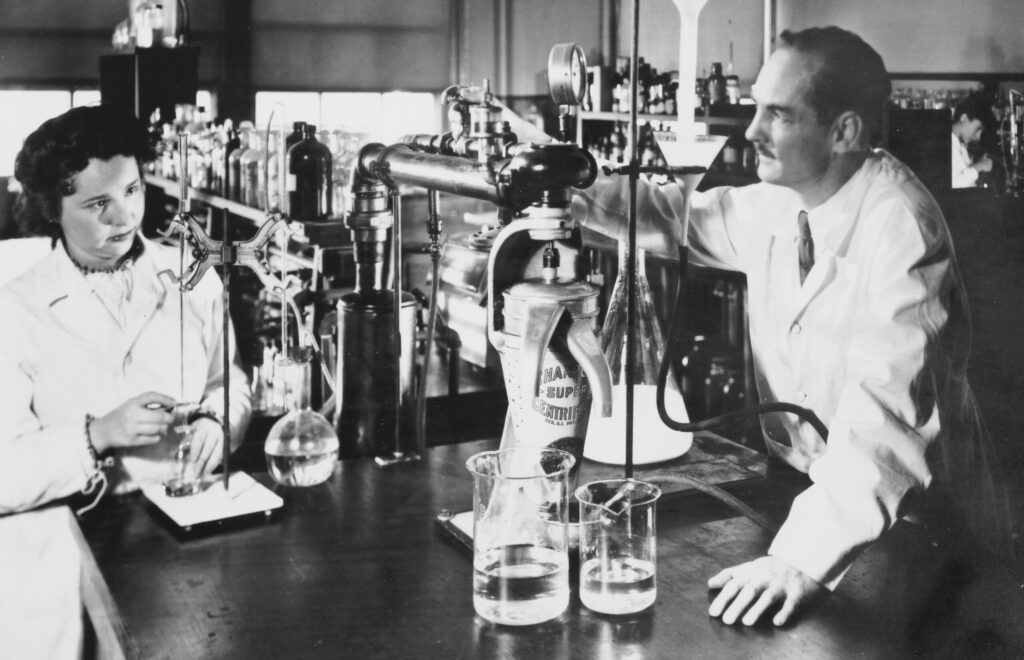
A Perfect Partnership
During World War II, jobs in chemistry were beginning to open up for women. Elion took a position testing food products for A&P grocery stores. She learned a lot about instrumentation but left when the position became too routine. She was then hired by Johnson and Johnson to synthesize sulfa drugs (see Gerhard Domagk), but the lab closed after only six months.
In 1944 she was hired by Hitchings at Wellcome, intending to stay only as long as she continued to learn. Meanwhile, she enrolled at Brooklyn Polytechnic Institute (now Polytechnic Institute of New York University) as a doctoral student, taking evening courses. When the Brooklyn Poly authorities informed her that it would be necessary to become a full-time student to complete a PhD, Elion decided that she did not want to leave the exciting research she was doing with Hitchings to gain her doctorate. She stayed at Wellcome for the remainder of her career.
A New Method of Drug Discovery
Rather than the traditional trial-and-error method of drug discovery, Hitchings believed in the necessity of a more rational method of research. The recent development of sulfa drugs led him to think that other substances that interfered with the metabolism of microbes—as sulfa drugs had been shown to do—could also be developed as drugs. Hitchings decided to target the synthesis of nucleic acids in cells. Now known as deoxyribonucleic acid (DNA) and ribonucleic acid (RNA), the nucleic acids determine the genetic makeup of cells and direct the process of protein synthesis. The idea was to look for differences in nucleic acid metabolism among normal human cells, cancer cells, protozoa, bacteria, and viruses that could be used to develop drugs that would selectively block the growth of cancer cells and of noxious organisms.
Hitchings assigned Elion to investigate the purines, including adenine and guanine, two of DNA’s building blocks, and their role in nucleic acid metabolism in cells. They soon discovered that bacterial cells required certain purines in order to make DNA. They reasoned that if they could prevent these purines from being incorporated along the metabolic pathway that leads to DNA synthesis, then they could stop the production of DNA and thereby stop cell growth. They set to work on compounds that did just this by locking up the metabolic enzymes necessary for purine incorporation.
Leukemia and 6-MP
By 1950 this line of research had paid off. Hitchings and Elion synthesized two antimetabolites, diaminopurine and thioguanine. Structural analogs of adenine and guanine, they attracted the metabolic enzymes, which latched onto them instead of the natural purines, thus blocking DNA production. These new chemotherapeutic drugs proved to be effective treatments for leukemia, a form of cancer characterized by a great increase in the number of white blood cells in the body.
Elion later substituted an oxygen atom with a sulfur atom on a purine molecule, thereby creating 6-mercaptopurine (also known as 6-MP and trade named Purinethol), a molecule closely related to thioguanine. The new material, 6-MP, was also used to treat leukemia. But with all of these new chemotherapeutic treatments, the disease was not cured; patients went into remission but then relapsed and died. Elion decided to examine everything about 6-MP, devoting six years of her life to this research. She discovered that treating childhood leukemia with a combination of 6-MP and one of several other drugs is more effective than using 6-MP alone. This method of treatment cures most patients.
Other Drug Successes
After this success Hitchings and Elion developed a number of additional drugs by using the same principle that had led them to 6-MP. Another form of leukemia could be treated with 6-thioguanine. Later, these related drugs were found not only to interfere with the multiplication of white blood cells but also to suppress the immune system. This latter discovery led to a new drug, Imuran (azathioprine), and a new application, organ transplants. Imuran suppressed the immune system, which would otherwise reject newly transplanted organs. The team also developed allopurinol (Zyloprim), a drug that reduces the body’s production of uric acid and therefore can be used for treating gout, a painful condition caused by the buildup of uric acid in the joints.
In the 1960s Hitchings and Elion determined that infectious diseases could be fought if drugs could be targeted to attack bacterial and viral DNA. This work resulted in pyrimethamine, which was used to treat malaria, and trimethoprim (Septra), which was used to treat meningitis, septicemia, and bacterial infections of the urinary and respiratory tracts.
Promotions and a Nobel Prize
As a result of these overwhelming successes Hitchings was promoted in 1967 to vice president of research, thus ending his active participation in research. Elion was promoted to head of the department of experimental therapy. Despite her new responsibilities she continued her research and was essential in the development of acyclovir, an antiviral drug effective against herpes. Although the drug was originally synthesized by Howard Schaeffer, Elion determined exactly how and why it worked. Acyclovir, marketed as Zovirax, interferes with the replication process of the herpesvirus—and only the herpesvirus—proving that drugs can be selective. This principle led to the eventual development of the AIDS drug azidothymidine (AZT) by Elion’s colleagues.
In 1970 the Wellcome Laboratory moved to Research Triangle Park, North Carolina, and Elion and Hitchings moved along with it. She retired in 1983, eight years after Hitchings. Along with James Whyte Black, Hitchings and Elion received the 1988 Nobel Prize in Physiology or Medicine for their discoveries of important principles for drug treatment.

